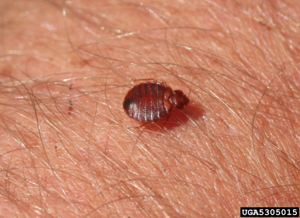Bed Bugs, Relax!
Over the past several years, bed bugs have become one of the most widely discussed pests in the media. Apparently absent for many years, the bed bug is making its presence known in hotels, apartments, dormitories, clothing stores and numerous other locations. While its name infers that it infests beds it can easily move away from the bed and into other nearby furnishings as well as cracks and crevices in the floors and walls. It can be transported in clothing and luggage from infested areas to areas where it is not already present. In some cases, it has also been known to infest seats in taxis and buses or clothing in department stores.
Relaxing may be hard to do when thinking about bed bugs, but there’s no need to panic either. Its presence may be a source of mental distress for people living with the insect but it is important to understand that bed bugs are not everywhere and they can be managed. Bed bugs are not known to transmit diseases but their bites can produce discomfort in some people especially when they’re bitten multiple times.
Because of the publicity given to bed bugs, they may be the first thing that comes to mind after returning from a stay at a hotel and noticing a bug bite, itch or welt. Yes, thinking of bed bugs gives one the creepy crawlies but remember that not every itch, welt or bug bite comes from a bed bug. While bed bugs shouldn’t be ruled out, other sources need to be considered which cause similar symptoms or reactions. These could include:
- Other biting insects such as chiggers, fleas, gnats, mites, mosquitoes or ticks.
- Identifying Insect Bites and Stings (American Academy of Pediatrics)
- Plants such as poison ivy, poison oak or poison sumac.
- Poison Ivy, Oak and Sumac (National Institute of Health)
- Chemicals such as detergents used on linens or fibers of certain fabrics.
- Contact dermatitis (National Institute of Health)
To some extent, a physician may assist in helping distinguish which of the above sources causes a skin condition. The only certain way to confirm the source of a bite, itch or welt may be to inspect and/or monitor the areas where a person was recently active to determine if one of the above listed causes is present.

As bed bugs continue to spread, it is important to learn about ways to identify them and to prevent and manage infestations. This ability should alleviate some fears and allow people to relax and enjoy their travels. The Virginia Department of Agriculture and Consumer Services' (VDACS) Office of Pesticide Services (OPS), thru a grant from the Environmental Protection Agency (EPA), undertook an outreach and education project to provide information regarding bed bugs to consumers. As part of the project, OPS partnered with Dr. Dini Miller, an entomologist at Virginia Tech, to develop several videos, fact sheets, and presentations related to bed bug identification, prevention, and management. The Fact Sheets are available in English or Spanish. You can find these Fact Sheets posted on the Bed Bug Outreach and Education Program section of the OPS website.
Related Resources
In addition to the resources provided by VDACS, you can also find information on the following websites:
Environmental Protection Agency, Pesticide Programs
EPA Bed Bug Information
The Bed Bug Information Clearinghouse
Centers for Disease Control and Prevention (CDC), Environmental Health Services
CDC Bed Bug Resources
CDC Health Advisory-Health Concerns about the Misuse of Pesticides for Bed Bug Control
Federal Trade Commission (FTC)
Battling Bed Bugs -Consumer Infomation
FTC Warns: Ineffective Bed Bug Treatments Can Take a Bite Out of Consumers' Wallets - Press Release (April 8, 2011)
National Pesticide Information Center (NPIC)
Understanding and Controlling Bed Bugs
National Center for Healthy Housing
What’s Working for Bed Bug Control in Multifamily Housing Report
National Pest Management Association, Inc. (NPMA)
All Things Bed Bugs
University of Florida, IFAS Extension
Bed Bugs and Book Bags: School Enrichment Curriculum for Grades 3-5 -This curriculum was developed by the University of Florida/ IFAS Extension in collaboration with the Jacksonville Bed Bug Task Force. Before the curriculum can be downloaded, teachers are required to view an online training presentation and take a brief quiz. The training takes about 30 minutes to complete.
Find a Product
If you are searching for a product to control Bed Bugs, EPA has developed an online tool to search for EPA-registered Bed Bug products depending on the site where it will be used. To utilize this tool visit:
EPA Bed Bug Search Tool
The Office of Pesticide Services also provides access to product information by sharing data with two public databases. The public can use these databases to query information such as state registration status, labels or other product specific information.
Kelly Solutions Pesticide Database Search
National Pesticide Information Retrieval System (NPIRS)